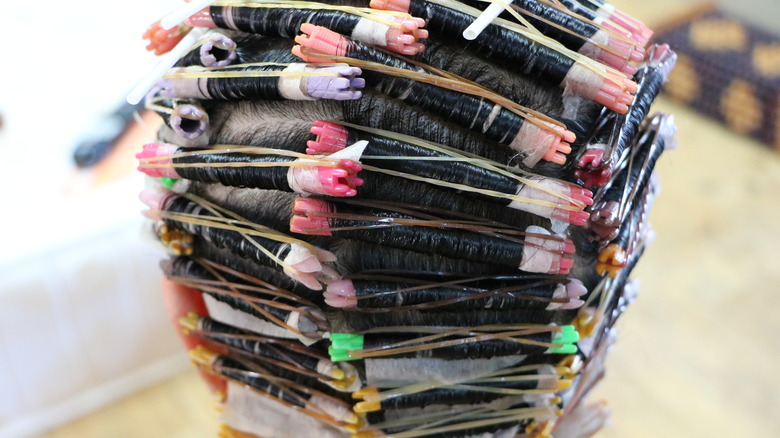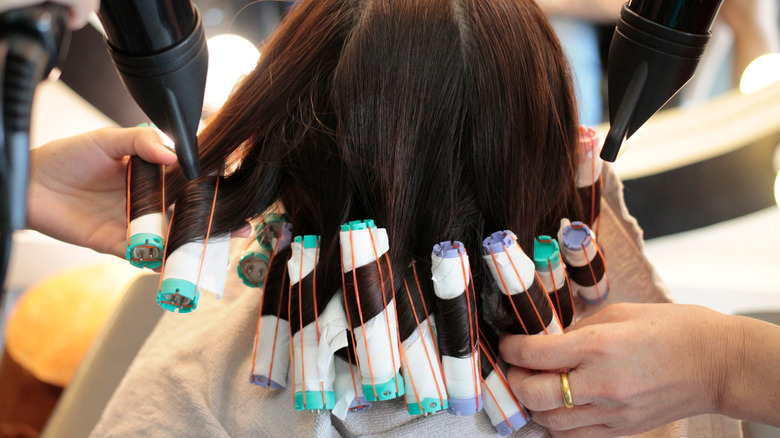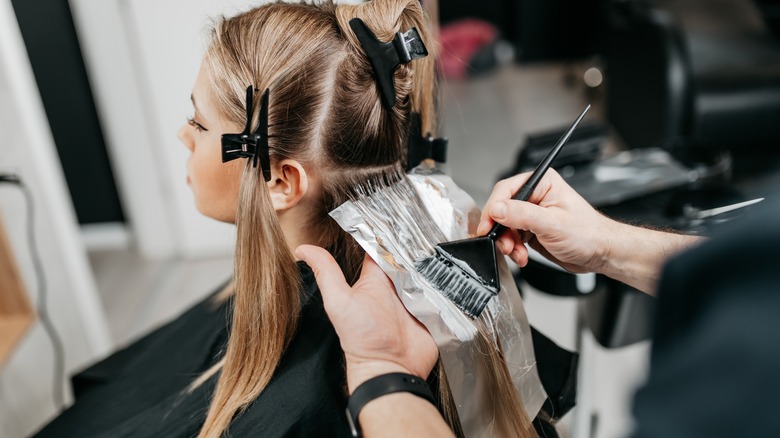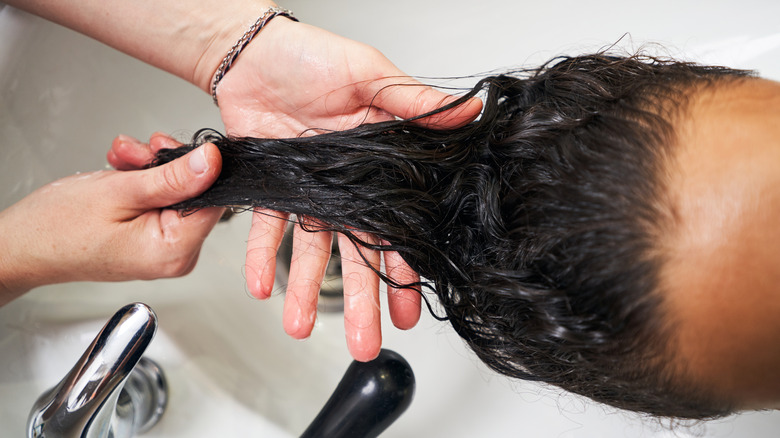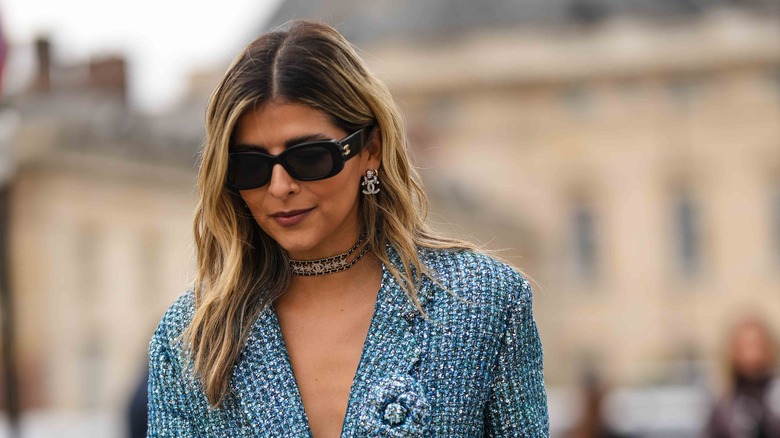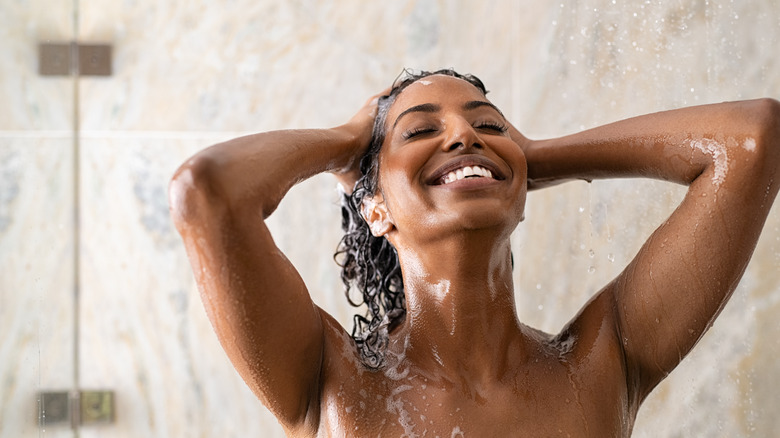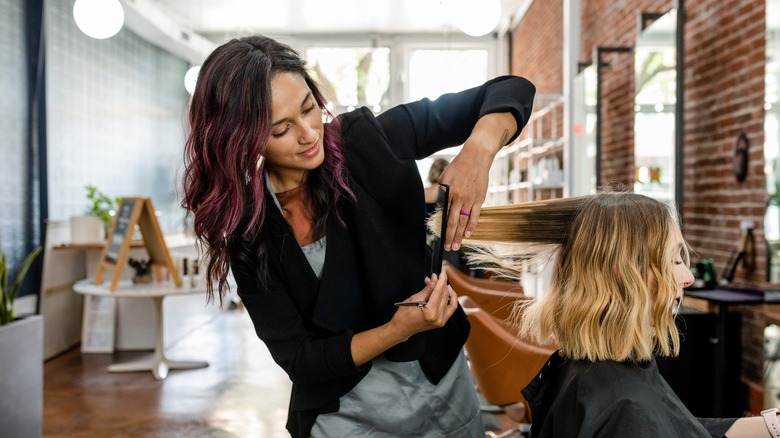Body Wave Perms Aren't Natural But Are They Right For You? Here's What We Know
Adding texture to locks can be a daily struggle for those with naturally straight hair. This hair type is one of the easiest to maintain, but when it comes to creating curls or waves, fine, straight hair tends to fall flat rather than hold on to your hard work from heat styling. Hairspray, mousse, and texturizing spray can help, but devotees of the wavy look might be looking for more of a permanent solution that can help cut back on their time in the mirror and reliance on curling irons.
Over the years, perms have earned an association with fluffy pin curls and regrettable yearbook photos, but the world of perming is much larger than most people realize. Spiral perms are the most well-known and are great for creating that all-over voluminous look, but your options don't end there. For a more natural look, consider a body wave perm. This style of perming creates texture and a subtle wave pattern similar to what you'd get from a blowout or salon style — no heat necessary.
How a body wave perm is different
Every perm follows the same basic process. A chemical solution, usually containing ammonium thioglycolate or glyceryl monothioglycolate, is applied to the hair, then styled using rods to create the desired texture. You'll get that stereotypical fluffy look when using small rods, but the size and direction can be modified to fit your goals. After the rods are placed in the hair, it's allowed to process; then, it's neutralized with an additional solution and styled.
Body wave perms still follow these steps, but they use larger rods and a less harsh solution to create bouncy volume and texture rather than pin curls. These styling treatments are great for those with straight hair that want a permanent blowout look, but they can also be used to create more consistency in your curl pattern if you have naturally wavy hair that leans frizzy or only seems to have texture in certain sections.
You can customize your rod size
Your perm's final results depend on the rod size you use, so it's important to share exactly what you want from your look with your hairstylist. Body wave perms use larger rods than spiral perms — usually upwards of an inch if you have long hair — but there's still quite a bit of room for personalization. Opting for rods on the smaller end of the body wave spectrum will get you a more traditional wavy look, while larger rods will leave you with something similar to a bouncy blowout. To get an idea of the impact of each size before heading into the salon, look at the diameter of your curling iron and decide if you'd rather have tighter or looser curls.
For a more natural look, your hair stylist might also alternate the direction and size of the rods. Naturally, wavy hair isn't ultra-consistent, so if you want to pull off that look rather than something more precisely styled, this will likely be the best bet.
It's important to have healthy hair
Unfortunately, perming your hair is an inherently damaging procedure. The process is designed to break down existing bonds in the hair and reform its structure, so even if you opt for gentler versions of this treatment, you can expect some damage. Because of this, your hair must be healthy. Before you head into the salon, previous straightening treatments, perms, coloring treatments, and heat damage should all be disclosed to your stylist. Sometimes, all it takes is a slight trim to bring your hair back to a healthy state, but it's not uncommon for stylists to refuse this procedure if your hair isn't prepared to face more stress.
The best candidates for a body wave perm are going to be those with virgin hair, but you shouldn't immediately write off the possibility if you've modified your locks in the past. Some people's hair is more resilient than others, and by talking to your stylist, you'll be able to determine exactly what's possible for your situation.
Your hairstylist will likely perform a detox treatment
Once your stylist has determined that your hair is healthy enough to undergo the perming process, they'll likely start by prepping it with a detox treatment. Over time, using products and hard water can cause buildup on our strands and the scalp. Occasional clarifying treatments, or the use of a clarifying shampoo, can help remove this buildup, resulting in hair that's shinier, better at absorbing products, and free from excess oil. These products usually contain sulfates, ingredients that can regularly dry your hair. Still, they're completely fine in moderation and pack a more powerful punch than sulfate-free shampoo.
This is especially important when it comes to perms. When applying a heavy-duty treatment, you don't want anything coating the hair strand that could interfere with the process. After the clarifying treatment, your stylist will likely follow up with a bond-repairing conditioner to create a healthy, moisturized base free from unwanted debris.
Body wave perms will last about six months
While perms are typically assumed to be permanent, they're actually more of a semi-permanent treatment. Over time, your hair will slowly return to its natural texture, though the style will stick around much longer than you did at home with a curling iron. Perms usually last about three to six months before your new texture begins to fade, although your hair type and level of upkeep can impact the staying power.
After this time is passed, you should head into the salon for a touch-up if you want to maintain your style. Over time, your new curls will begin to fall a bit, but the main concern is usually regrowth, especially if you opted for a tighter body wave. As your hair grows, the new growth at the roots will still show your natural texture, sometimes causing your hair to look disjointed if you forgo your next appointment.
Upkeep at home is incredibly important
You might leave the salon with your ideal look, but if you don't maintain your body wave perm correctly, it won't last much longer than one wash. Firstly, and the rule we all learned from "Legally Blonde," is that you should never wash your hair in the first 48 — sometimes 72 — hours after your perm. After this point, you're free to wash your hair as normal, though it's a good idea to reduce the frequency of your washes and focus more on hydration to ensure your locks stay healthy and shiny.
To make your perm last as long as possible, it's also a good idea to change a few parts of your daily routine to better align with your new texture. Try a satin or silk pillowcase or bonnet, swap your regular brush with a wide-tooth comb, and look to deep conditioners and moisturizing treatments if your hair feels brittle.
Going back to your straight hair could be a challenge
While a perm is more of a semi-permanent procedure, this doesn't mean it's not a major change. Chemically altering your hair's texture means you'll likely have to switch up your hair routine, deal with a bit of damage, and commit to additional appointments for proper upkeep. If you're on the fence or think you'll start missing your long, straight hair, it's probably best to go for something more temporary, as heat styling permed locks, especially routinely, is a recipe for additional damage.
"Trying to blow-dry or flat-iron permed hair will stress your strands out," hairstylist and perm specialty Mallory Granrath says in an interview with Refinery29. "If you want to revert back to straight hair, I recommend letting it grow out or committing to a short cut if you want to keep your hair healthy." With that being said, however, a body wave perm is a convenient and often-overlooked option for those with straight hair — it's just important to consider if you're willing to make the investment.

